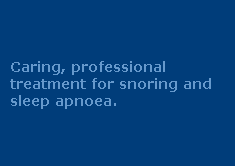Acoustic Reflection Technology
| Acoustic reflection technology is a non-invasive diagnostic method for accurately measuring the 'patency' or openness of the airway. Different forms of device are used for measuring the upper airway (the pharyngometer) and the nasal airway (the rhinometer). The accuracy of this sonar-like technology has been well documented however it is relatively rare in Australia. The Sleep Therapy Clinics are the only professional practices in Australia which focus solely on the treatment of SDB conditions, and our clinics are among the very few practices of any type which have invested in this equipment, to ensure proper diagnosis and treatment for our patients. |
 |
| Precise and reproducible results are displayed in the form of an airway cross-sectional graph which shows air volume at various distances into the airway. This allows for accurate assessment of the airway problem and helps determine if an oral appliance is the appropriate treatment choice. If an oral appliance is decided upon as the best course of treatment (by a specialist sleep physician, working in consultation with the dentist who takes the pharyngometer readings) the acoustic data ensures the appliance is designed for maximum airway opening and maximum effectiveness. |
 |
Without the use of acoustic technology a practitioner can only guesstimate the optimum fitting for an oral appliance. Dentists who offer oral appliance therapy as a sideline to their standard dental practice without this type of diagnostic technology are 'guessing' as to the optimum type and position of an appliance.
How is Pharyngometry done?
Pharyngometry is non-invasive, completely painless and only takes a few minutes.
The patient sits upright and places the end of the device into their mouth or nasal cavity. Sound waves will then be directed into the airway and a number of simple breathing exercises will be done to locate the most unstable and narrow portions of the airway. Different jaw positions will then be tested to determine the best possible position. Measurements and impressions will be taken to record this position and the oral appliance will be constructed to these specifications, to ensure maximum effectiveness.
 |
 |
Research:
1. AC, Butler JP, Millet EJ, Hopin FG, Dawson SV. Airway geometry by analysis of acoustic pulse response measurements. J Appl Physiol. 1977;43:523-536.
2. Jan MA, Marshall I, Douglas NJ. Effect of posture on upper airway dimensions in normal human. Am J Respir Crit Care Med. 1994;149:145-148.
3. Fredberg JJ, Wohl MB, Glass GM, Dorkin HL. Airway area by acoustic reflections measured at the mouth. J Appl Physiol. 1980;48:749-758.
4. Marshall I, Marin NJ, Martin S, et al. Acoustic reflectometry for airway measurements in man: implementation and validation. Physiol Meas. 1993;14:157-169.
5. Brooks LJ, Byard PJ, Fouke JM, Strohl KP. Reproducibility of measurements of upper airway area by acoustic reflection. J Appl Physiol. 1989;66:2901-2905.

